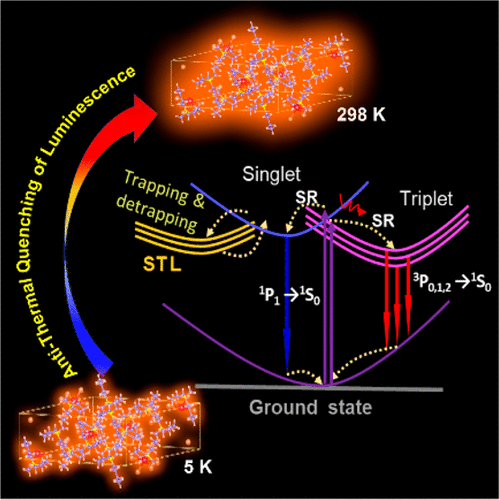当前位置:
X-MOL 学术
›
J. Phys. Chem. Lett.
›
论文详情
Our official English website, www.x-mol.net, welcomes your
feedback! (Note: you will need to create a separate account there.)
Antithermal Quenching of Luminescence in Zero-Dimensional Hybrid Metal Halide Solids
The Journal of Physical Chemistry Letters ( IF 4.8 ) Pub Date : 2020-03-26 , DOI: 10.1021/acs.jpclett.0c00293 Bin-Bin Zhang 1 , Jia-Kai Chen 1 , Ju-Ping Ma 2, 3 , Xiao-Fang Jia 4 , Qing Zhao 5 , Shao-Qiang Guo 4 , Ya-Meng Chen 1 , Qi Liu 1 , Yoshihiro Kuroiwa 5 , Chikako Moriyoshi 5 , Junying Zhang 4 , Hong-Tao Sun 1
The Journal of Physical Chemistry Letters ( IF 4.8 ) Pub Date : 2020-03-26 , DOI: 10.1021/acs.jpclett.0c00293 Bin-Bin Zhang 1 , Jia-Kai Chen 1 , Ju-Ping Ma 2, 3 , Xiao-Fang Jia 4 , Qing Zhao 5 , Shao-Qiang Guo 4 , Ya-Meng Chen 1 , Qi Liu 1 , Yoshihiro Kuroiwa 5 , Chikako Moriyoshi 5 , Junying Zhang 4 , Hong-Tao Sun 1
Affiliation

|
Zero-dimensional (0D) hybrid metal halides have emerged as a new generation of luminescent phosphors owing to their high radiative recombination rates, which, akin to their three-dimensional cousins, commonly demonstrate thermal quenching of luminescence. Here, we report on the finding of antithermal quenching of luminescence in 0D hybrid metal halides. Using (C9NH20)2SnBr4 single crystals as an example system, we show that 0D metal halides can demonstrate antithermal quenching of luminescence. A combination of experimental characterizations and first-principles calculations suggests that antithermal quenching of luminescence is associated with trap states introduced by structural defects in (C9NH20)2SnBr4. Importantly, we find that antithermal quenching of luminescence is not only limited to (C9NH20)2SnBr4 but also exists in other 0D metal halides. Our work highlights the important role of defects in impacting photophysical properties of hybrid metal halides and may stimulate new efforts to explore metal halides exhibiting antithermal quenching of luminescence at higher temperatures.
中文翻译:

零维杂化金属卤化物固体的发光抗热猝灭
零维(0D)杂化金属卤化物由于其高的辐射复合率而成为新一代的发光磷光体,类似于它们的三维表亲,它们通常表现出发光的热猝灭。在这里,我们报告在0D杂化金属卤化物中发光的抗热淬灭的发现。使用(C 9 NH 20)2 SnBr 4单晶作为示例系统,我们表明0D金属卤化物可以证明发光的抗热淬灭。实验表征和第一性原理计算的结合表明,发光的抗热淬灭与(C 9 NH20)2 SnBr 4。重要的是,我们发现发光的抗热淬灭不仅限于(C 9 NH 20)2 SnBr 4,而且还存在于其他0D金属卤化物中。我们的工作强调了缺陷在影响杂化金属卤化物的光物理性质中的重要作用,并可能激发探索在高温下表现出发光抗热淬灭作用的金属卤化物的新努力。
更新日期:2020-04-24
中文翻译:

零维杂化金属卤化物固体的发光抗热猝灭
零维(0D)杂化金属卤化物由于其高的辐射复合率而成为新一代的发光磷光体,类似于它们的三维表亲,它们通常表现出发光的热猝灭。在这里,我们报告在0D杂化金属卤化物中发光的抗热淬灭的发现。使用(C 9 NH 20)2 SnBr 4单晶作为示例系统,我们表明0D金属卤化物可以证明发光的抗热淬灭。实验表征和第一性原理计算的结合表明,发光的抗热淬灭与(C 9 NH20)2 SnBr 4。重要的是,我们发现发光的抗热淬灭不仅限于(C 9 NH 20)2 SnBr 4,而且还存在于其他0D金属卤化物中。我们的工作强调了缺陷在影响杂化金属卤化物的光物理性质中的重要作用,并可能激发探索在高温下表现出发光抗热淬灭作用的金属卤化物的新努力。











































 京公网安备 11010802027423号
京公网安备 11010802027423号